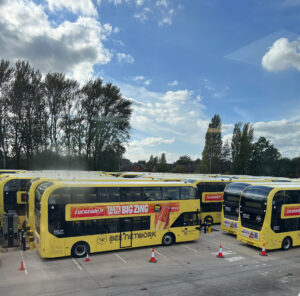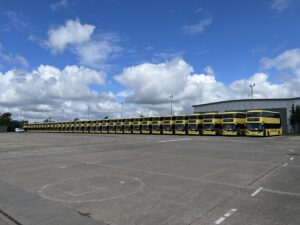 Hot off the heels of our integrated ticketing and automatic vehicle location (AVL) delivery for TfGM, we grabbed a chinwag over a cup of joe with Andreea Reardon, Chief Product & Technology Officer, to find out all about it…
Hot off the heels of our integrated ticketing and automatic vehicle location (AVL) delivery for TfGM, we grabbed a chinwag over a cup of joe with Andreea Reardon, Chief Product & Technology Officer, to find out all about it…
So, let’s talk TFGM… Can you give us a whistle-stop tour of the latest innovations delivered so far?
 Where to begin!? We delivered TfGM’s ETMs and on-bus AVL hardware, alongside authorisation-related functionality for TfGM to use with its operators, service control features, reporting and analytics, a new cEMV integration, and so much more.
Where to begin!? We delivered TfGM’s ETMs and on-bus AVL hardware, alongside authorisation-related functionality for TfGM to use with its operators, service control features, reporting and analytics, a new cEMV integration, and so much more.
This is the first launch of our newest ticket machine, the Next Generation ETM. It is based on an Android tablet at its heart that basically delivers the Ticketer ETM functionality, with significant improvements in performance and processing.
The second product launch we delivered was our vehicle communication gateway, the Smart Gateway. It integrates on-bus equipment to connect and consolidate comms of various IT infrastructure, and comes with advanced dead-reckoning and GNSS which allows us to deliver improved location accuracy even in challenging environments.
On the backend, data and RTI side of things, we delivered a complete first with an extension of our Ticketer Portal for TfGM to use with its operators!
Can you tell us more about this extension of the Ticketer Portal?
Absolutely. This extension of the portal establishes TfGM as the portal ‘owner’ so to speak, and allows them and their operators the ability to manage their day-to-day operational needs. For example, it gives TfGM a holistic overview of their operators’ ticketing and operational environment, plus the ability to manage global or operator-level configuration data, such as tickets, services, timetables etc… We have also delivered enhanced reporting to better serve the needs of TfGM as the owner and operators.
The portal owner has a 360 view of everyone involved, while operators have the ability to access and manage their own individual areas of the portal. It’s basically their own operator view where they too can see any relevant information communicated from TfGM, as well as their own information from a ticketing and AVL perspective.
This extension and our existing Ticketer Portal both include Corridor Management, which is the ability to manage part of the road network that has multiple services running alongside the same section, and where network performance can be monitored across multiple services or operators.
We also launched Headway Management, which monitors the time between vehicles on a service which can be used to manage frequent services in busy city locations. This can be particularly helpful in effectively staggering the bus fleet to meet frequency demands, or if there’s a disruption or delay to a service. Buses can be held back to help regulate a service rather than there being a bottleneck of buses arriving at a stop at the same time, if for whatever reason an earlier bus is running late. For Greater Manchester passengers it’s great, as it’ll help the old adage about three buses coming at once!
We’ve also introduced the ability for service controllers to monitor the bus fleet performance and have a comprehensive view of what’s happening with their services. For example, are they running on time? Are there any cancelled services? We already had some of this functionality within Schedule Adherence, but we’ve enhanced that even more, so it’s fit for purpose for service controllers to monitor and manage performance.
Last but not least, Cause Codes and the ability to annotate trips have been introduced for operators to use in those circumstances where they need to cancel, add trips, or manage diversions in general, and for TfGM to understand why that’s happened. Operators can select from a prescribed set of reasons to describe why a certain event has taken place, and are able to use ‘Annotations’ to provide more context and reasoning.
How could all this enhanced reporting empower TFGM to make more informed decisions and provide the best possible public transport to Greater Manchester?
 We have already delivered TfGM a comprehensive toolset for them to gain visibility and insight into how their operators’ services are run across Greater Manchester. We are also very excited to work very closely with the TfGM team and deliver enhancements and further innovation during our partnership.
We have already delivered TfGM a comprehensive toolset for them to gain visibility and insight into how their operators’ services are run across Greater Manchester. We are also very excited to work very closely with the TfGM team and deliver enhancements and further innovation during our partnership.
We want to find out what is actually useful for TfGM but also for the operators, and how we could better support them in running the bus operation and the decision-making via enhanced data analytics and insights.
We’re aiming to continuously evolve what we’ve already delivered throughout the partnership with TfGM and our goal is to add even more value as we go, so they can offer the best possible journeys for their passengers.
How did this partnership align with TFGM‘s vision for improving public transportation in the Greater Manchester area?
We as a company are really passionate about providing best in class technology for public transport. We’re constantly trying to innovate and build partnerships with our customers, transport authorities, and operators to deliver seamless end-to-end journeys.
Our goals as a company therefore definitely align with the goals of TfGM in terms of providing easy access to public transport and a unified experience. We’re also very alike in the passion we have around providing better transport and basically getting more people on buses, which is really what this is all about.
We’ve only really discussed everything that’s been delivered in phase 1 of the rollout! What’s next on the horizon to deliver for TFGM?
There is tranche 2 and 3, so we will look at rolling out more of our on-bus hardware, ETMs, and the Smart Gateways on the rest of Greater Manchester buses, as well as on boarding new packages either for existing operators or new ones.
Alongside this and as mentioned before, we will be working closely with TfGM to understand how we can help them on this journey and how our technology can further enhance and deliver value for the bus passengers in Greater Manchester.
This is the first example of franchising outside of London, with that in mind, what can the people of Greater Manchester expect to see from this?
 A very beautiful yellow Bee Network bus fleet! I think the most notable things delivered are flexible and integrated ticketing between bus and tram, improved customer information, and a unified passenger experience across the Bee Network buses.
A very beautiful yellow Bee Network bus fleet! I think the most notable things delivered are flexible and integrated ticketing between bus and tram, improved customer information, and a unified passenger experience across the Bee Network buses.
They say that teamwork makes the dream work… How important was it to work closely with TFGM to deliver franchising and all of these innovations on time and on plan?
We’ve provided TfGM’s ticketing solution for a few years now, and in that time we were fortunate to have developed a very strong partnership for us to continue building upon. We always tried to maintain an honest and frequent communication channel with TfGM to ensure we were ready to go.
As with any big programmes of work, we had a strong governance and structure in place to make sure all stakeholders were aligned, led by project managers on both sides. And most importantly, we used and enhanced existing working groups but also created new ones within different business areas to make sure we were aligned all the time.
We also had to work closely with other TfGM suppliers. We always aim to be flexible and collaborative when integrating with third parties, so it was great to work alongside others to deliver jointly for TfGM.
Lastly, after a herculean effort by all involved, was there a ‘pinch me moment’ for you during the launch?
My ‘pinch me moment’ was definitely when I was sat in Bolton depot on Sunday 24th at about 4:00am watching the first bus head out from the depot.
It was a mammoth effort from not only our team, but also the TfGM teams and the operators to get everything ready and on the road. Whilst we’d had a ‘soft’ launch with the school services a little earlier in the month, the sheer size and volume of work that was needed to get the Sunday and Monday services out was insane. So, my ‘pinch me moment’ was definitely that first bus leaving the depot!

